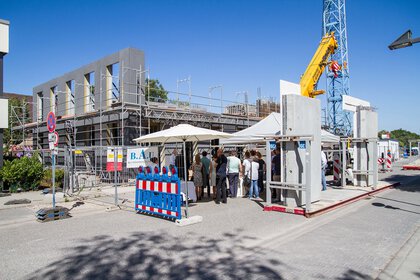New building materials in the construction industry
Innovative building materials shape the future of construction. Scientists and technologists are working at high pressure to research and develop new building materials and to further develop those that have proven their worth. They must be efficient, durable, sustainable and risk-free. The aim is to increase efficiency, profitability and environmental compatibility. New materials enable better approaches to revolutionize architecture and give cities a new appearance.
Carbon concrete: The high-performance material is a composite of concrete and carbon fibers—and thus stronger, lighter and more durable than conventional concrete. Carbon does not rust, a concrete covering, as with reinforced concrete, is not necessary. The consumption of sand and the CO2 emissions in connection with the production of reinforced concrete could thus be significantly reduced. The building material can be produced from any substance that contains carbon. Currently, researchers use lignins, a waste product in the production of wood. Compared to reinforced concrete, carbon also scores in terms of load-bearing capacity and weight.
Substantial material savings
In 2019, a two-storied reference object made of carbon was created on the campus of Technische Universität (TU) Dresden (University of Technology Dresden) under the direction of the TU consortium „C³ Carbon Concrete Composite“. C³ Chairman Prof. Manfred Curbach, Head of the Institute for Solid Construction: “The C-Cube is intended to illustrate the properties of carbon concrete and be a prime example of filigree, lightweight and lean construction.”
In the Mannheim office park Eastsite, Dreßler Bau from Stockstadt erected the world's first building with a full textile concrete sandwich facade. The facade surface of the four-storied office building is 1000 m². As Christoph Suttrop of Dreßler Bau points out, the thin-walled outer shell contains only two tons of alkali-resistant glass fiber textile mats. A conventional reinforced concrete facade would have required almost eight tons of steel.
Heavy-duty floor elements
Researchers from the Department of Architecture of the ETH Zurich (Eidgenössische Technische Hochschule) have developed heavy-duty but lightweight floor elements with a curved shape reminiscent of cathedrals. Being only two centimeters thick and 70 percent lighter than conventional concrete, they require no steel reinforcement. The shape alone enables maximum load-bearing capacity. 3D printing was applied to reduce manufacturing costs. However, the elements were not made of concrete, but of sand in combination with a special binding agent.
Philipp Block from ETH Zurich: “The novel floor boards are now being tested in the construction of a two-storied guest house to be erected on the roof of our research building.”
Safety through polymer concrete
Highly topical are building materials that can dampen shock waves in the event of earthquakes or explosions due to their high energy absorption capacity. This is achieved by a polymer concrete that contains porous organic fillers as well as fibers for reinforcement. Due to the high pore volume, this building material reduces the destructive impact of detonations.
Innovative building material: Wood concrete
With the novel, extremely load-bearing building material “wood concrete”, researchers from the Swiss “Resource Wood” initiative presented another innovation in the field of concrete production. Honed wood replaces the corresponding gravel and sand content with a volume share of more than 50 percent wood.
Cross laminated timber for high-rise construction
High-rise buildings made of cross laminated timber (CLT) are in no way inferior to concrete structures in terms of stability and fire resistance. Considering its extreme strength, high fire resistance and good carbon dioxide capture capabilities, CLT offers significant advantages: The foundation need not be as complex, and construction can be performed faster and quieter.
Mushrooms as insulating material
At the Fraunhofer Institute for Environmental, Safety and Energy Technology (UMSICHT) in Oberhausen, Germany, processes are currently being developed through which the part of mushrooms growing underground—the so-called mycelium—can be processed into insulating material or building material. The US start-up company Ecovative has already produced a foam-like material from mycelia. Depending on the added by-products, it could be suitable not only as an insulating material, but also as a resource-saving building material and a welcome alternative to plastic, polystyrene or plywood.
Nano in the construction industry
Nanomaterials are materials whose special properties are based on the nanoscale size of their components. Due to the larger surface area—in relation to their mass—nanomaterials achieve altered physical-chemical properties. Nanotechnologies are already being successfully applied in the construction industry to improve the mechanical, energetic, hygienic or aesthetic properties of building materials.
The research of the Fraunhofer business unit “Nano in Construction” focuses on the question of how nanomaterials can be integrated into existing production processes or value chains. This includes their addition to the materials on the one hand, and the application of nanomaterials as coating on the other.
Membranes—the trend building material
They can be used to construct lightweight and cantilever buildings that are superior to comparable glass constructions in price and flexibility. For example: Allianz Arena. Within the framework of the business unit “Building with Membranes”, seven institutes of the Fraunhofer Building Innovation Alliance are driving the development of this technology.
Photo material: © B.A.U. GmbH & Co.KG, Mannheim

